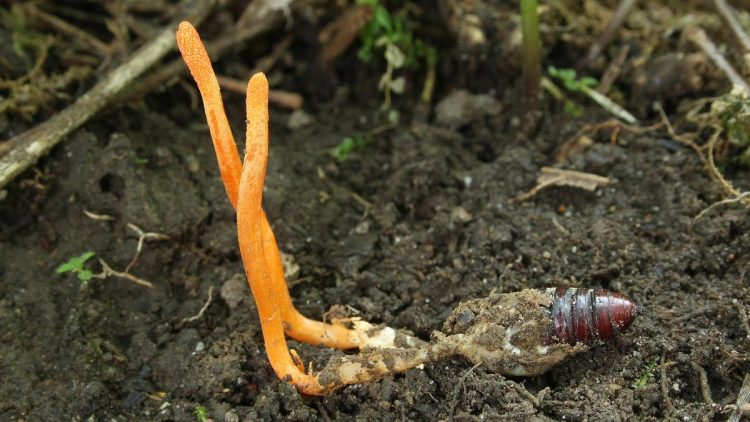Just in time for Halloween, scientists in Korea say they’ve found a better way to grow an insect-destroying mushroom in the lab. Their work could make studying these fungi easier, which is important, since they and the chemicals they produce may actually have medicinal uses for humans, creepy as they are.
The fungi is known as Cordyceps. Members of this genus, along with a related but distinct genus called Ophiocordyceps, are parasitic, usually feeding on insects and other arthropods. These fungi will invade and often kill their hosts, though not before using them as fuel to grow their fruiting bodies (technically, this is the part of the fungi that we call the mushroom) and release new infectious spores into the world to start the process all over again. Some members of Ophiocordyceps are also known for “zombifying” their ant hosts by manipulating their behavior before death to ensure their optimal survival.
As horrifying as their way of life is, some members of Cordyceps are considered food in parts of Asia. They’ve also been used in traditional Chinese medicine and more recently are being sold as supplements (supplements of any kind, it should be noted, have little quality control and aren’t necessarily harmless). And early research has suggested that Cordyceps produce chemicals that could have beneficial health effects, particularly a compound called cordycepin. Some studies have indicated, for instance, that cordycepin might have anti-viral or cancer-fighting properties.
This research has largely come from animal or lab studies, though, meaning it will take a lot more evidence in humans to confirm any potential benefits. These experiments and any eventual widespread use of Cordyceps will also require having ample supplies of the fungi or their compounds, and that’s a challenge. Though these fungi are found throughout the world, they’re hard to find and harvest from the wild. There are now ways to cultivate them in the lab, but the current methods only yield low amounts of healthy Cordyceps or cordycepin, making them hard to scale up.

Cordyceps militarisPhoto: charnsitr (Shutterstock)
G/O Media may get a commission
Researchers at Chungbuk National University tried to improve on these methods, which usually use brown rice as the growth medium. They theorized that these mushrooms would grow better on richer sources of protein—namely, insects. They also guessed that their diet would affect how large the fungi grew and how much cordycepin they produced, so they tested out different types of insects. These insect nurseries were kept growing for two months before the researchers harvested the Cordyceps. The team’s findings, published Wednesday in Frontiers in Microbiology, suggests that their insect theory was right on the money.
“Cordyceps grown on edible insects contained approximately 100 times more cordycepin compared to Cordyceps on brown rice,” said study author Mi Kyeong Lee, a professor at Chungbuk, in a statement from Frontiers.
As expected, though, there were differences in how the insect food affected their growth. The fungi were most plentiful when they fed on mealworms and silkworm pupae, for instance. But they actually produced the most cordycepin when they fed on Japanese rhinoceros beetles. The team’s work also indicates that it was the fat content of the insects, not their protein, that predicted how much cordycepin the mushrooms produced. The rhinoceros beetles were especially full of a type of fat called oleic acid, and once the team introduced oleic acid to a low-fat insect feed, the Cordyceps’ production of cordycepin rose as well.
“The cultivation method of Cordyceps suggested in this study will enable the production of cordycepin more effectively and economically,” Lee said.
While these scientists may have found an improved method of growing Cordyceps in the lab, you probably shouldn’t expect mass production just yet. The authors note that churning out insects on an industrial scale isn’t easy, either. So if these freaky fungi do turn out to be medically valuable, there’ll be more challenges ahead in developing them for mass use. That said, there is at least one research team at Oxford University actively studying a modified version of cordycepin as a cancer drug in early human trials.
Source by gizmodo.com





























